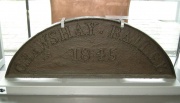Difference between revisions of "Crawshay Bailey"
| Line 11: | Line 11: | ||
1820 Partner in the [[Nantyglo Ironworks]] on Matthew Wayne's departure. | 1820 Partner in the [[Nantyglo Ironworks]] on Matthew Wayne's departure. | ||
The two brothers developed the Nant-y-glo works, and, later on, the Beaufort | The two brothers developed the Nant-y-glo works, and, later on, the [[Beaufort Ironworks]]. | ||
1825 [[William Crawshay]], his cousin (the then proprietor of [[Cyfarthfa Ironworks]]), may have prevented Crawshay Bailey from continuing as owner of [[Rhymney Iron Co|Rhymney Iron Works]]. | 1825 [[William Crawshay]], his cousin (the then proprietor of [[Cyfarthfa Ironworks]]), may have prevented Crawshay Bailey from continuing as owner of [[Rhymney Iron Co|Rhymney Iron Works]]. | ||
Latest revision as of 11:27, 5 February 2020

Crawshay Bailey (1789-1872), iron-master and M.P.
1789 Born, the younger son of Joseph (or John) Bailey of Wakefield, and Susannah, sister of Richard Crawshay, iron-master of Cyfarthfa Ironworks.
c.1801 Joined his older brother, Joseph, at Cyfarthfa, working in their rich uncle's iron-works.
1809 Uncle died; at some point Crawshay left Cyfarthfa
1820 Partner in the Nantyglo Ironworks on Matthew Wayne's departure.
The two brothers developed the Nant-y-glo works, and, later on, the Beaufort Ironworks.
1825 William Crawshay, his cousin (the then proprietor of Cyfarthfa Ironworks), may have prevented Crawshay Bailey from continuing as owner of Rhymney Iron Works.
Crawshay Bailey constructed the tramway from Rhymney to Bassaleg
Foreseeing the potential of the South Wales coal basin, he bought up many large areas at their agricultural value — at Aberaman , Mountain Ash , and in the Rhondda valley.
1833 The Bailey brothers, Crawshay and Joseph, acquired Beaufort Ironworks from Messrs. Kendall and Co and added it to their Nantyglo Ironworks. Beaufort works were mainly employed in supplying pig iron to the new rolling mills at Nantyglo.
1837 Bought the Aberaman estate with its mansion, the home of the Mathews family, from the executors of Anthony Bacon II.
Collieries were sunk at Cwm-bach alongside the Aberdare Canal.
1845 with Sir John Josiah Guest, Bailey obtained a Parliamentary Act for the Aberdare Railway, to connect with the Taff Vale Railway at Abercynon.
1846 Constructed blast furnaces, etc at Aberaman Ironworks.
1847 First iron was puddled at Aberaman.
1852 MP for Monmouth boroughs from 1852 to 1868.
1867 Conveyed the Aberaman estate with the collieries, ironworks, brick-works, private railway, etc., to the Powell Duffryn Steam Coal Co
1872 Died at Llanfoist House on 9 January. Left his only son, Crawshay Bailey (1821-1887), as heir.
1872 Detailed Obituary in The Engineer [1]
See Also
Sources of Information
- Welsh Biography Online - Crawshay Bailey [1]

